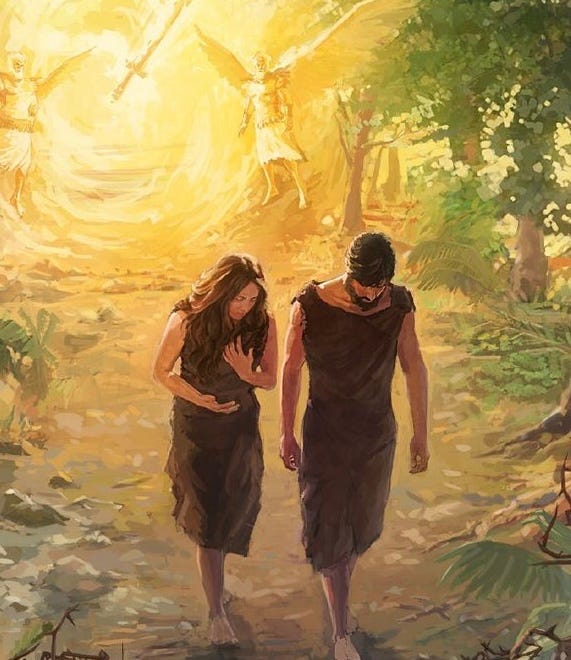Typology: Part 2 Adam, Eve and All Humanity
In the Epistle to the Romans, Paul discusses how Christ is a type of Adam. As I mentioned in my last post, Jesus is the antitype. This means He is the fulfilment of Adam. Through His death and resurrection, He resolves the problem of death which came into the World when the First Man sinned.
Romans 5 v 12-14
Therefore, just as through one man sin entered the world, and death through sin, and thus death spread to all men, because all sinned— For until the law sin was in the world, but sin is not imputed when there is no law.
Nevertheless death reigned from Adam to Moses, even over those who had not sinned according to the likeness of the transgression of Adam, who is a type of Him who was to come.
A type is a literary pattern. This pattern of Adam can be seen in other stories in the Bible too.
Abraham and Sarah
One example is Abraham and Sarah. In Genesis 18, God tells them that they are going to have a child. As they are both old and Sarah is unable to have children, she laughs.
When we marry this event with the story of Adam and Eve in the Garden of Eden, we notice some revealing parallels.
In both cases God gives a command; ‘do not eat of the Tree’ and ‘you are going to have a child’.
Eve is tempted and doubts God’s command, and equally Sarah doubts what God says.
Adam and Eve hide from God, while Sarah uses lies, a way of using words to hide a true intention.
The difference here is that Abraham does not scoff like Sarah, but trusts God. While Adam prefers the counsel of his wife. He fails to follow God’s command, but Abraham does.
In this example, Sarah is a type of Eve and Abraham is a type of Adam. Though Abraham makes the right choice.
King Xerxes and Esther
This story is set in Babylon. The Jews had been exiled and now had to live amongst the Babylonians. These events happen after the time of Daniel.
The antagonist, Haman, persuaded the king to make a ruling that anyone who doesn’t bow down to him will be executed. This means, all the Jews would be killed if this law was enforced.
Mordecai speaks to Queen Esther, she herself being a Jew. He asks her to speak to the king and persuade him to change his mind.
She sets out a banquet and invites the king to dine with her. During the meal, she makes her request. He retires to the garden to think about it. He returns and changes his mind.
In this story, we see the Eden narrative typologically play out again. Where King Xerxes is a type of Adam, Queen Esther is like an Eve and this time Mordecai plays the role of the Serpent.
Suggesting Mordecai is like the Serpent may seem odd, but he is more like an opposite-type. A type which acts in a way which is opposite to the original. So whereas the Serpent tempted Eve to disobey God’s command, in order to try and destroy Creation. Mordecai instead asks Esther to go against the king’s command and save the Jews.
I find it interesting that Esther provides food for the king, just like how Eve gives Adam the fruit. And the king makes his decision in the garden, just like Adam.
Adam’s choice brought death, King Xerxes decision stops the genocide of the Jews.
Jesus and Mary Magdalene
In the gospel according to John, we see a dialogue between Jesus and Mary Magdalene.
She enters the empty tomb and sees two angels. Symbolically, these represent the flaming sword and the Angel guarding the way to the Garden of Eden.
John 20 v 13
They asked her, “Woman, why are you crying?”
“They have taken my Lord away,” she said, “and I don’t know where they have put him.”
She turns round, and Jesus asks her the same question. She is deceived and doesn’t recognise Jesus.
When we think of Eve in the Garden of Eden, she wasn’t just tempted, but was deceived. Like Eve, Mary is in the garden, her eyes deceived her and she couldn’t see Jesus.
Upon realising it was Him, she seeks to touch Him. But Jesus stops her.
Adam on the other hand, embraced his wife’s desire. Jesus rejects Mary’s and chose God’s will instead.
Typology and Internal Dialogue
From these examples, we can see there is what appears to be an internal dialogue in Scripture. Where the same narrative pattern is repeated, but where different characters and motives are substituted.
This helps us to better understand Scripture. And is way to unpick the more difficult and unusual stories.
The Second Eve
If Jesus is the Second Adam, then who is the Second Eve?
Traditionally Mary, Jesus’ mother, fulfils that role. When the Angel comes to her and asks whether she will obey God’s command, she does so.
Unlike the First Eve, who listened to the Serpent (the fallen angel), then tempted her husband and death came to humanity. Mary, after accepting the words of the Angel, she bears a baby who becomes the Saviour of the World, reversing the curse brought by Adam.
The other possibility is that the Second Eve is the Church. We see how Eve is the wife of Adam. The ultimate goal of the Church is to become the bride of Christ at the wedding feast of the Lamb.
Additionally, just as Adam was put into a deep sleep (a euphemism for death) before Eve could be created. So too, Christ dies on the Cross before the Church could be formed.
I think the title Second Eve could equally be given to Mary and the Church, after all Mary is also part of the Church.


